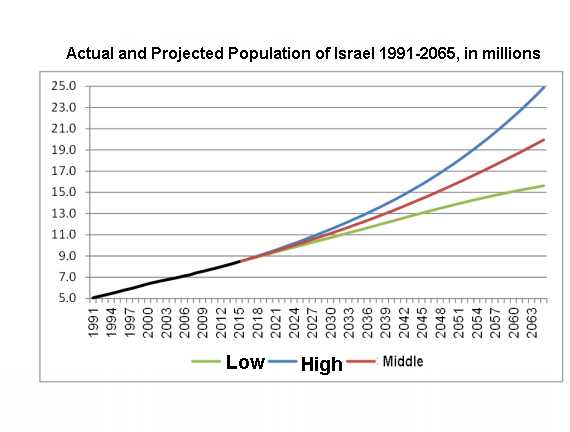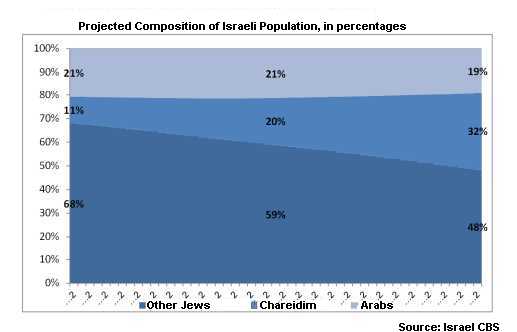This week marks the 50th anniversary of the Six Day War. Those old enough to remember, recall the anxiety felt in chutz la'aretz about the dangers facing the community in Eretz Yisroel. Now, 50 years later, it is appropriate to review in some detail the tremendous Divine blessings that we have experienced since then. The data comes from the Israeli Central Bureau of Statistics.
 Three scenarios for population growth in Israel over the next 50 years
Three scenarios for population growth in Israel over the next 50 years
The general fertility rate (i.e. the average number of children a woman is expected to produce in her lifetime) in Jerusalem stands at 3.87 per woman. This rate is higher than the national figure of 3.09. The overall fertility rate of Jewish and other women in Jerusalem stands at 4.28 children, which is relatively higher than the national overall figure of 3.04. The average number of children born to Arab women in Jerusalem (3.23) is also higher than the national average figure for Arab women (3.13). The Arab number is falling over time. In the course of 2015 23,581 children were born to Jerusalem residents, of which 15,438 were born to Jewish and other women (65%) and 8,143 to Arab women (35%). Babies born to Jerusalem residents during this year constituted 13.2% of the national figure, more than the Jerusalem population share of the overall national figure (10.2%).
The average Jerusalem household numbers 3.9 people, which is larger than the national average of 3.3 per household and the average figure of household members in other large cities. Jerusalem boasts the highest number of families, with seven members or more (15%). 67% of Jerusalem families are at least traditionally religious, including parents with children of all ages.
In the school year of 2015-16, 75,244 students filled the elementary school benches (of Jewish education), with some 49,000 under chareidi supervision, 13,500 studying in government-religious schools and 12,500 in secular government schools. The chareidi portion is growing, the government-religious is stable and the secular schools are shrinking.
The makeup of the Jewish population in Jerusalem from 2010-2016 changed with regards to the average of years 2002-2009: the adult Jerusalem chareidi population of aged 20 and up rose by 5% (with the joint rate of chareidi and general-religious constituting 7%). The secular and traditional (less than fully religiously committed) population of Jerusalem fell by 7% during these two periods.
Of Jews aged twenty plus, 35% define themselves as chareidi; 19% as religious, 12% as traditionally religious, 12% as borderline traditional and 21% as secular, with 1% uncommitted; this is compared to the national breakdown where 10% define themselves as chareidi, 11% religious, 13% traditional religious, 22% as borderline traditional and 44% secular.
In 2015, the percent of citizens of twenty and up feeling safe in walking alone in the neighborhoods of large cities (of populations of 200,000 and more) during evening hours was lower than the national average of 81%. The lowest sense of security within large cities at night was registered in Jerusalem at 71%. Nonetheless, in chareidi neighborhoods numerous women are on the streets even at 10 p.m.
Those employed in the work force of Jerusalem in 2016 was registered at 52.4% as compared to the 64.1% of the national average. Within the Jewish population in Jerusalem, the figure of those employed in the Jerusalem work force reached a 57.9% as compared to the national Jewish average of 68.1%. The Arab citizens employed in the Jerusalem work force was 41.6% (45.3% of the overall national Arab population).
In 2015, the average net monthly income in Jerusalem stood at 11,877 shekel ($3,200). The average gross income stood at 13,702 ($3,700) shekel which represented 71.2% coming from employment wages and 28.8% from various allocations and subsidies, pensions and pension funds etc. The average budget expenditure stood at 10,663 shekel.
In the past decade, the number of registered vehicles in Jerusalem rose by 47% percent. 78% of all tourists coming to Israel in 2016 visited Jerusalem and 51% of tourists arriving in Israel remained [at least] overnight.
General Figures about the State of Israel and a Forecast till 2065
At the end of 2015, the population of Israel stood at 8.5 million residents. The population is expected to reach 10 million people by the end of 2024, and 15 million by the end of 2048. By the end of the forecast, in 2065, it is expected to reach 20 million people. These are the middle projections.
Expected changes in the makeup of the Isreali population over the next 50 years

No significant changes are predicted in the general population makeup division between Jews and others, and Arabs. The ratio of Jews and others by 2040 is expected to remain constant in relation to its present figure of 79%, with 21% for the Arab population. In fifty years, the ratio of the Jewish-and-others is expected to rise to 81%, while the Arab rate will fall correspondingly to 19%.
The percentage of the chareidi population is expected to rise from 11% of the overall Israeli population in 2015 to 20% by 2040 and to 32% by 2065. Within the group of Jewish-and-others, the chareidi population is predicted to rise from 14% in 2015 to 24% in 2040 and to 40% by 2065. 75% of Israeli children are Jewish, of which 56% are not chareidi and 19% chareidi, with 25% being Arab. The proportion of Jewish children, non-chareidi and other, is expected to drop to 35% in the next fifty years. The portion of Arabs in the child population is also expected to drop to a 15% by 2065. In comparison, the proportion of chareidi children in the population will reach a level of 49% by 2065.




